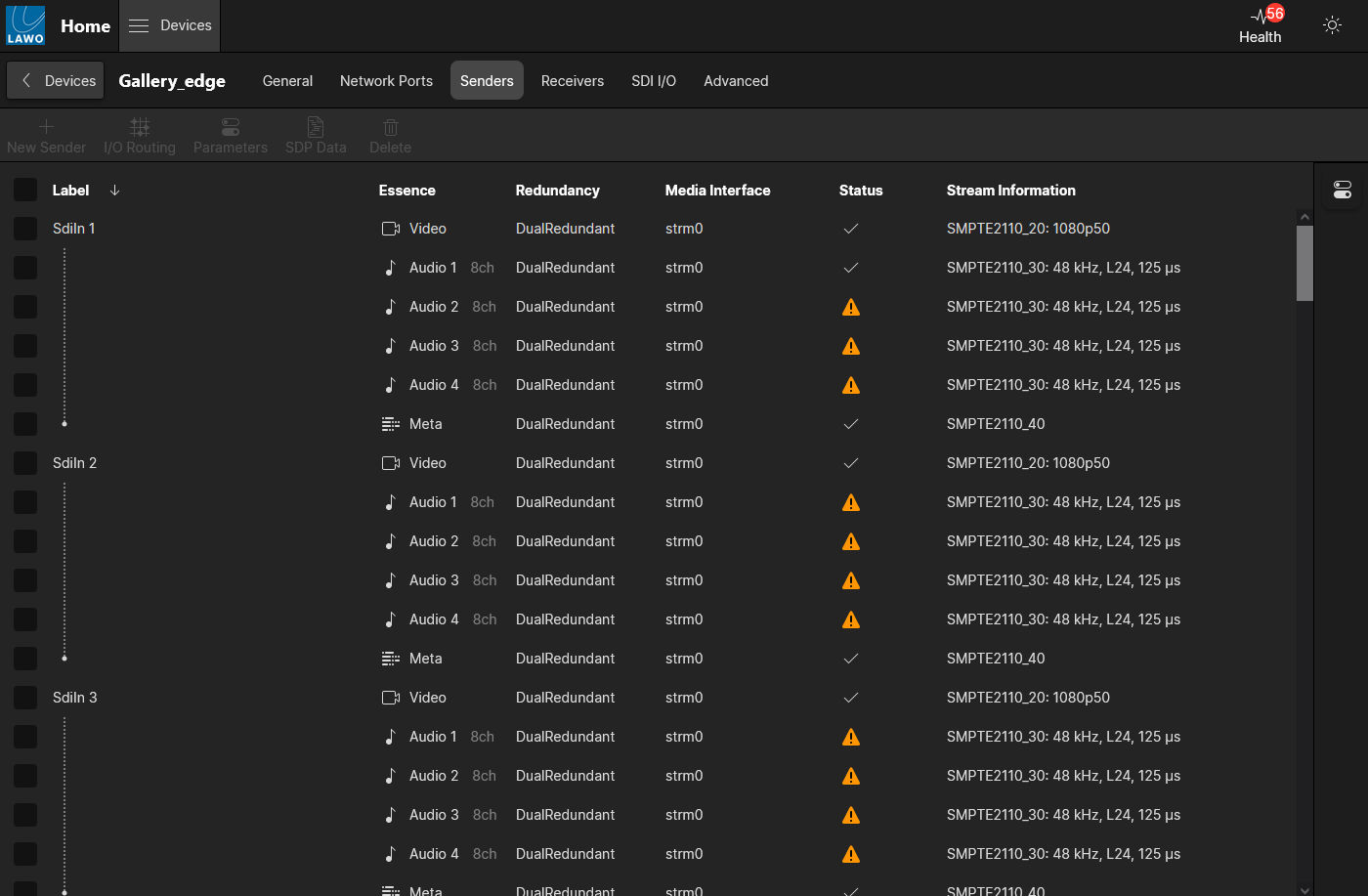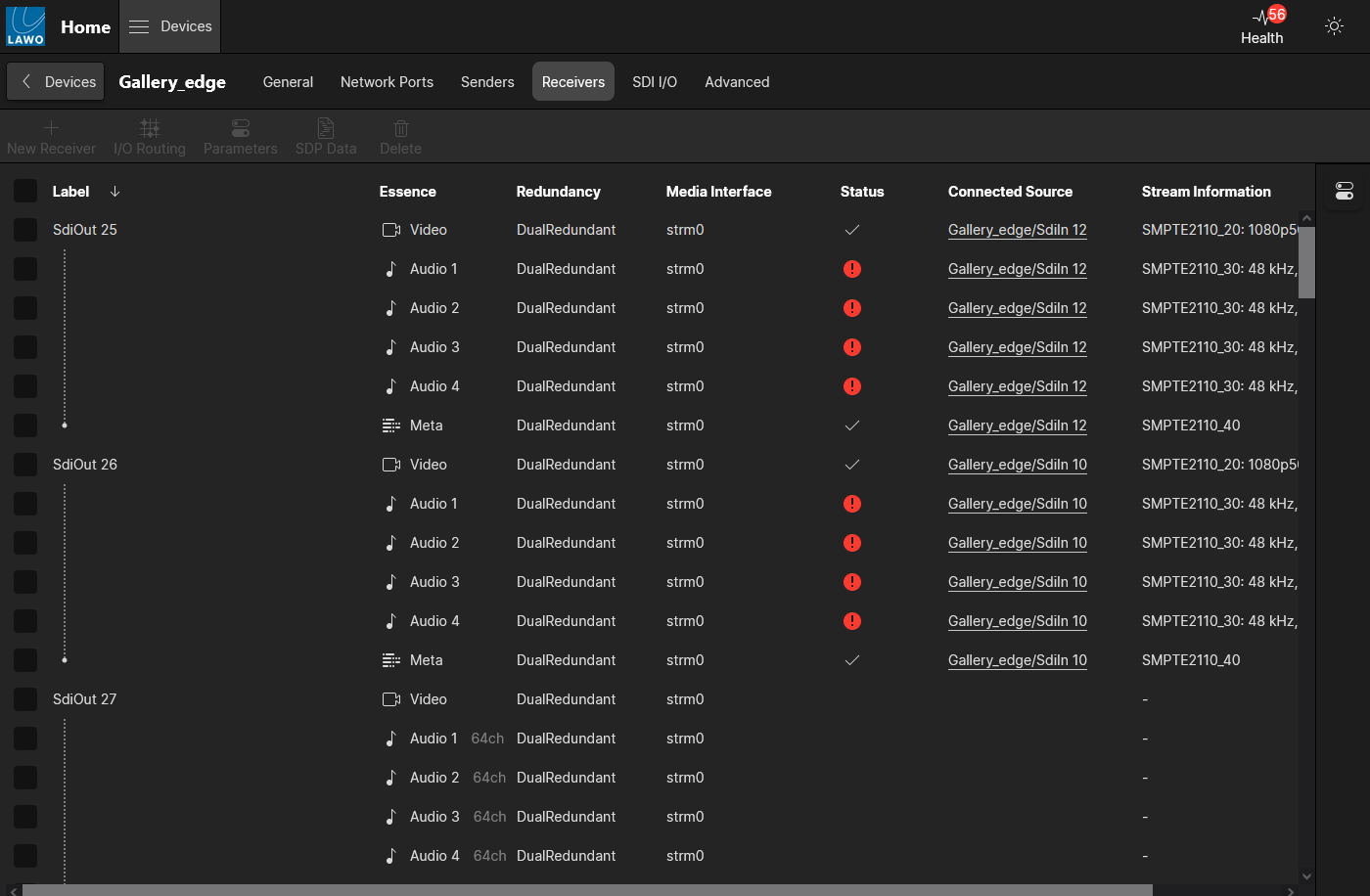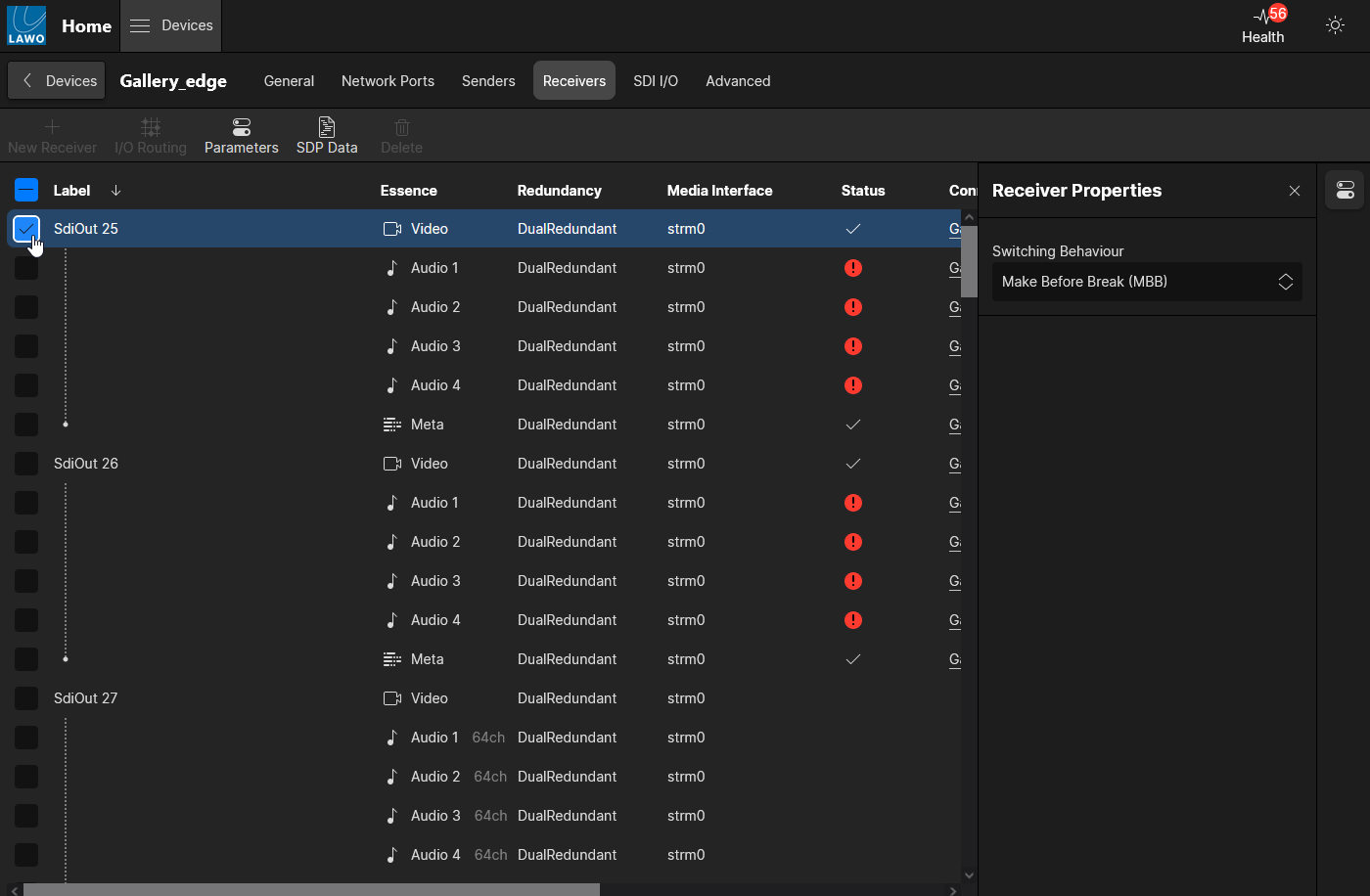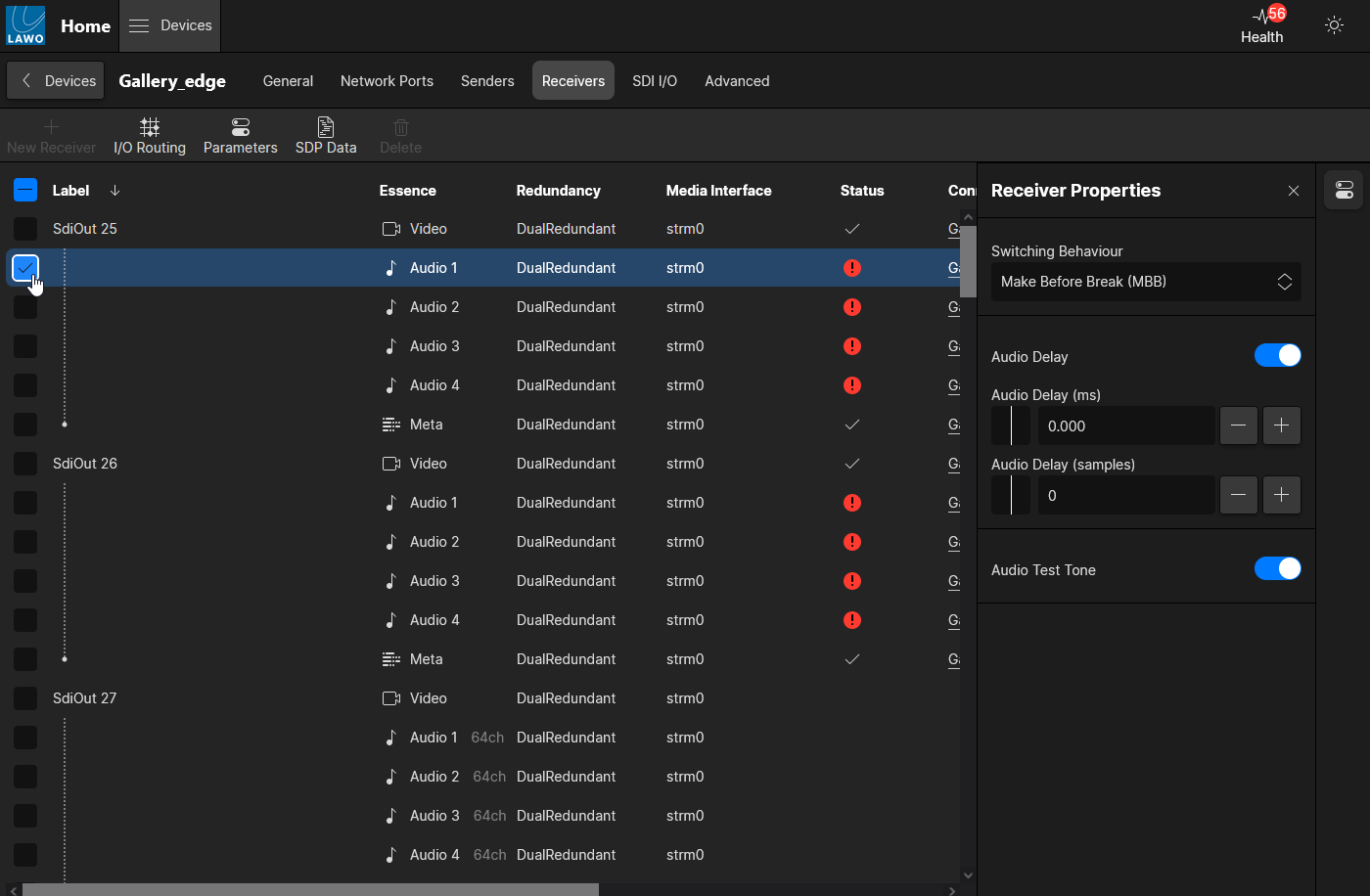.edge - IP Senders and Receivers
This topic describes how to check and configure the IP senders and receivers.
Overview
Each processing blade supports a number of IP senders (and receivers) that stream content to (and from) the media network. The senders and receivers are pre-defined, where each one handles the three essence types of an SDI I/O: 1 x Video, 4 x Audio, 1 Meta(data).
The total number of senders and receivers is determined by the SDI I/O configuration. For example, 24 senders + 24 receivers for a fully-licensed processing blade.
Note that, for each converted signal, there are two sets of parameters: the sender/receiver parameters (on the IP side) and the input/output parameters (on the SDI side). Here we deal with the former. For more information on the latter, see .edge - SDI Inputs and Outputs.
IP Senders and Receivers
The Senders and Receivers tabs list all of the pre-defined senders and receivers. From here, it is possible to adjust the I/O Routing (for the audio streams), edit the streaming parameters or access the SDP data. In addition, the "Show Sidebar" button (on the right) reveals the available properties for the selected sender or receiver. For example, for an audio essence, you can adjust the delay or turn on the test tone.
From the main "Devices" list, click on the processing blade label (to open the "Device Details" as described earlier). Then select either Senders or Receivers.
IP Senders
The Senders tab lists all of the streams transmitted from the processing blade to the network. The screenshots below show the two possible views: with the Properties sidebar turned off and on.

.edge - IP Senders (overview)

IP Senders (audio sender properties)
Sender Information
The following information is displayed for each stream:
- Label - identifies the stream to other network users. For .edge it is pre-defined and cannot be edited.
- Essence - describes the type of content carried by the stream: Video, Audio or Metadata. For audio streams, you will also see the number of channels (e.g. 8ch).
- Redundancy - shows the redundancy status of the stream. A DualRedundant stream is SMPTE ST2022-7 compatible.
- Media Interface - shows the name of the network interface(s) sending the stream.
- Status - indicates the status of the stream. Hover over the icon to reveal more information.
- Stream Information - shows a summary of the stream parameters. e.g. for a video stream: the IP standard and video format; for an audio stream: the IP standard, sample rate, codec type and packet time.
Video Sender Properties
For video streams, all of the adjustable parameters are on the SDI side, and so there are no properties for a video sender.
Audio Sender Properties
For an audio sender, the following properties can be adjusted:
- Audio Test Tone - on/off
- Frequency - selectable from the drop-down menu.
- 0.5 dB Decreasing Ramp per Channel - on/off. Turn this option on to vary the audio level of the test tone.
The audio test tone can be used to line-check the audio path from the sender (once a connection is made via the Stream Routing page).
Other Operations
If you select a sender, then a number of other functions become available:
- I/O Routing (for audio senders only) - assigns the SDI audio inputs to the IP sender channels. Otherwise known as audio shuffling.
- Parameters - check or edit the stream parameters.
- SDP Data - view or copy/paste the stream's SDP.
IP Receivers
The Receivers tab works in a similar manner, but this tab lists all of the available receivers. Each one can be used to receive a stream from the network either by making a connection in the Stream Routing page or by editing the receiver's SDP data.

.edge - IP Receivers (overview)

IP Receivers (video receiver properties)

IP Receivers (audio receiver properties)
Receiver Information
The following information is displayed for each receiver. This is similar to the information for senders but adds the Connected Source column (to show the connected stream).
- Label - identifies the receiver within the network. For .edge it is pre-defined and cannot be edited.
- Essence - describes the type of content that can be received: Video, Audio or Metadata. For audio streams, you will see the number of channels (once a connection is made).
- Redundancy - shows the redundancy status of the receiver. A DualRedundant receiver can be connected to either a redundant or non-redundant stream.
- Media Interface - shows the name of the network interface(s) used by the receiver.
- Status - indicates the status of the receiver. Hover over the icon to reveal more information.
- Connected Source - shows the name of the connected stream (once a connection is made).
- Stream Information - shows a summary of the connected stream parameters. e.g. for a video stream: the IP standard and video format; for an audio stream: the IP standard, sample rate, codec type and packet time.
Video Receiver Properties
For a video receiver, there is a choice of two switching modes: either Make Before Break (MBB) or Break Before Make (BBM).
Audio Receiver Properties
For an audio receiver, the following properties can be adjusted:
- Switching Behaviour - either Make Before Break (MBB) or Break Before Make (BBM) as above. To achieve clean switching for audio streams, MBB is recommended.
- Audio Delay - on/off and delay time adjustment (in ms or samples).
- Audio Test Tone - on/off.
Other Operations
If you select a receiver, then a number of other functions become available:
- I/O Routing (for audio receivers only) - assigns the IP receiver channels to the SDI audio outputs. Otherwise known as audio shuffling.
- Parameters - check or edit the receiver parameters.
- SDP Data - view or copy/paste the receiver's SDP.